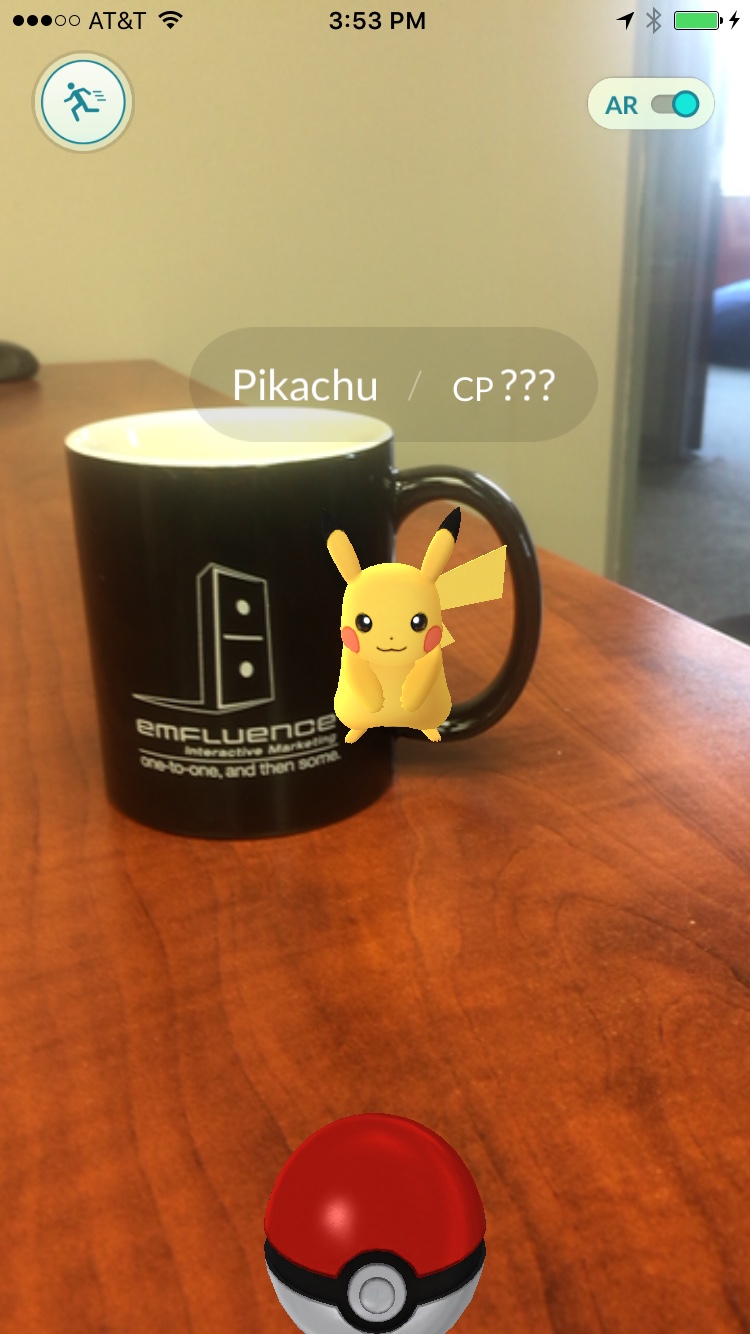Certainly, you or a loved one has contracted the Pokémon Go fever currently sweeping the country. It’s everywhere. It has even infected a good portion of the emfluence office (We’re all on Blue Team in case you were wondering.)
The game has already become a legitimate sensation, overtaking Instagram and Twitter for daily active mobile users since launch. People can’t stop talking about it on social media, and I can only imagine office productivity throughout the country has taken a nose-dive since release.
For those who may not know, Pokémon Go is a free-to-play, augmented reality mobile experience, where you “capture” Pokémon in the real world. It uses your phone’s camera and GPS to place cute cartoon monsters throughout the environment around you. Users capture and collect them, and can even trade and fight them against other users. You can check in at specific locations called “Gyms” and fight for control of your neighborhood for your team. As you continue to play, you can upgrade and “evolve” your Pokémon, making them more powerful.
If you’ve played any free-to-play games on your phone in the past, this formula should sound pretty familiar. The truth is, Pokémon Go isn’t much different than most popular mobile games. There is an addicting cycle that develops with catching, upgrading and fighting Pokémon, with the option to purchase items that speed up the process. What is so different about Pokémon Go that has turned it into an overnight sensation?
The main reason (other than the strength of the Pokémon brand itself) is augmented reality. Pokémon Go uses augmented reality in an exciting new way, making users feel like they’re part of the game like never before. The success of Pokémon go can yield some valuable lessons for marketers about the future of augmented reality and mobile marketing.
Community Building

The main reason why people seem so enthralled and engaged with Pokémon Go is the sense of community that the game has already successfully built. It all starts with something simple: Teams.
Right from the beginning of your Pokémon Go game, you’ll be given a chance to pick a team and fight for that team to control gyms in the area. To take control of a gym, you fight your Pokémon against a lineup of Pokémon from the members of the team defending the gym. When your team takes control, your Pokémon will now be on defense.
The game is simple and fun, and you immediately feel like you’re helping your team become the very best like no one ever was. It pulls at our collective competitiveness as humans, as well as our desire to cooperate.
"Community" is a bit of a buzzword in the marketing world these days. Every brand is trying to build a community of some sort around their brand. Adding a game between teams seems like an easy way to do it, but it often falls flat in execution. Polls are a great way to get people to take sides, but they only go so far in connecting your audience to your brand. What Pokémon does well is engage with players after they have chosen teams.
A Shared World
Possibly the most revolutionary thing about Pokémon Go is that everything occurs in a shared world. Players occupy the same world, and what happens in your area happens to every nearby player. Just moments ago, everyone in my office got a notification of a nearby Pokémon, and everyone immediately got up to go find it together.
There have been numerous attempts at an augmented reality experience, but none have been open-world like this. With Pokémon Go, the game feels like a window to a world that already exists and is living around you.
This has already led to some pretty exciting experiences for players. For example, a player can set a lure at a public location, bringing tons of Pokémon to that location for 30 minutes. Other nearby players can see the lure, too, which means they’ll be drawn to the location to catch something for their collection. What can result, especially in a busy or highly populated area, is a sort of impromptu meet up. Complete strangers will be drawn by the same common goal: to catch them all.
My coworkers already have countless stories of meeting new people nearby playing Pokémon Go. Stores near these public locations are drawing in customers with these lures, or holding promotions for those who play the game.
Think of the possibilities of an experience like this for marketers! If your augmented reality experience offers enough of a reward, you can draw people together organically to achieve that reward. For example, a band at a festival could set a lure for their fans, drawing them to a specific location on the festival grounds for autographs or exclusive memorabilia. Big box stores can draw customers to items on special through the app. As AR becomes more widely adopted by mobile users, even businesses who can’t afford their own app can draw customers to their stores.
This Is Just the Beginning
As with most free-to-play games, Pokémon Go is only going to continue to change and grow. New features will come online over time, and players will continue to work to capture bigger and better Pokémon.
The bottom line here is that while Pokémon Go is already revolutionizing the way people think about augmented reality, and this is only the beginning. I’m sure they’ll eventually introduce another feature that will make us dream of another way to use this technology. Even if you don’t play Pokémon Go today, you should keep an eye out for how it develops in the future.
